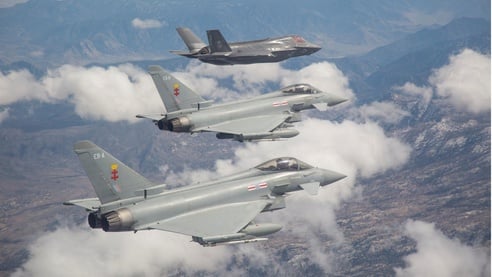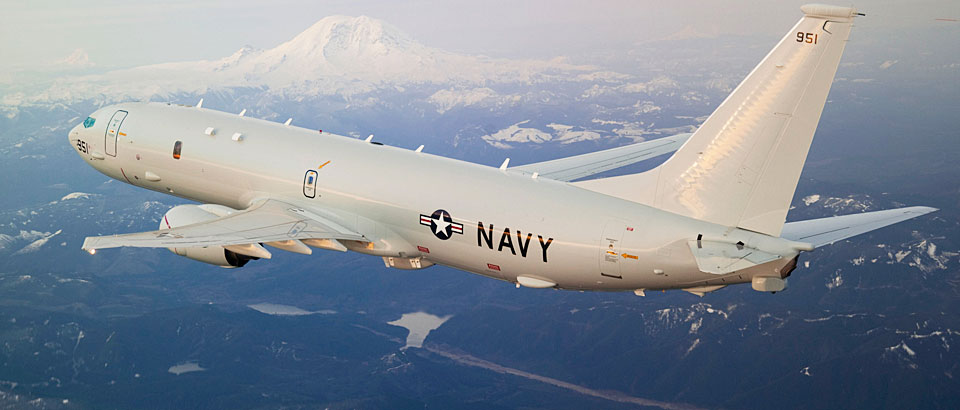Allies Can Help US Lower Weapons Costs, Build New Force
Posted on

F-35 and Typhoons
Shifting from a primary focus on counterinsurgency land wars to building a high intensity combat force able to prevail against peer competitors is a significant challenge for the United States and its closest allies after 15 years of COIN.
A key dynamic within this effort is the crucial opportunity the US and its closest allies have to learn from each other thanks to the number of core weapon systems being bought at the same time.
The F-35, P-8, Triton and Growler are all being bought by the United States and by some of our closest allies, notably Australia.
And when we see American F-35As going to RAF Lakenheath this month, what can be missed is that at RAF Marham — located less than 30 miles from RAF Lakenheath — the first British squadron of F-35s will be stood up BEFORE the US does so at RAF Lakenheath. One hopes the US plans to ensure it gets as much synergy as possible between the bases where F-35s will be based in the UK.
Norway is also drawing upon this interactive modernization process to stand up its own 21st century combat force.
At the same time, Australia’s Wedgetail command and control aircraft and its KC-30A airborne tanker have been deployed for some time and are cutting edge systems NOT found in the US inventory.
Additionally, the British RAF is modernizing its Typhoons with long-range strike systems that are complementary to the F-35Bs, and they are doing it before the US has made similar adjustments to its legacy aircraft.

First Australian F-35
Key allies have also put in play Concepts of Operation (CONOPS) ahead of the United States. Ironically, these advances are often achieved with systems built by key US defense firms. And there is no ambiguity in British or Australian minds about the shift to fifth generation warfare, as opposed to lingering debates in the US about remaining mired in a last-generation mentality.
It is not a question of selling systems to these allies AFTER the US has shaped a new strategy and a new capability; it is about reshaping it with them in an interactive transformation process.
The problem for the United States is the barriers posed by our legacy defense acquisition system and other cultural and policy barriers.
While Australia’s Wedgetail has demonstrated it’s a clear 21st century alternative, we are still pursuing AWACS modernization. While the global fleet of Airbus 330MRTT tankers (flown by Australia, Saudi Arabia, United Arab Emirates, United Kingdom, Singapore and France) are a reality; the US Air Force has NO new tankers.

Wedgetail refueled by KC-30A
It is crucial for the United States to tap our allies’ new systems and develop new concepts of operation to capitalize on the new force; yet our acquisition system and stove-piped service dominated requirements process limits the potential for the United States.
How has this happened?
During my latest visit to Australia I participated in a Williams Foundation seminar that was debating in public how best to build an integrated joint force from the ground up.
When your country is engaged in things like modernizing AWACS by 2030, or a Super Hornet versus F-35 conversation, or keeping a A-10 tank killer designed 40 years ago, it is difficult to boldly lead a military transformation.
After the seminar, I discussed the challenge with retired Air Marshal Geoff Brown. “The shoots are there for fundamental change. But the legacy approach is like a giant tree blocking out the sun for the shoots to grow.”
He pointed out that the notion that one would modernize AWACS is “simply amazing to me. With the fuel savings alone from replacing the AWACS fleet with Wedgetails a new fleet could be paid for in a few years.
“But in the US system it is difficult to get a tradeoff from keeping the old legacy systems running and simply shutting them down; putting the new systems into the force; and leveraging them rapidly. The new systems require new sustainment approaches.”
He touched one of the most sensitive political issues in America’s acquisition and logistics system, the depots that repair and maintain our weapons: “The F-35 provides a great opportunity for a very different sustainment system but with the congressionally-mandated depots the opportunities for an innovative industrial-government partnership are severely constrained.”
As the Trump Administration looks to rebuild the force, “even 50 to 60 billion dollars more won’t correct the kinds of logistical shortfalls which the United States faces. I’m a little frightened for the future if the US forces keep going down the path they’re on at the moment. Just wishing that additional money will be available to operate the legacy force structure isn’t going to solve the problem. The current funding issues and congressional limitations placed on the Services will drive the US towards and increasingly hollow force,” he said.
Brown sees a significant opportunity to unlock potential by shaping new logistical approaches such as the C-17 support model.
“There are green shoots all over the United States. The United States is the most innovative society in the world, without a doubt.
“One green shoot is the C-17 support model. By using a very innovative industrial working relationship with the deployed force, support costs are going down, not up. So why not adopt this model for the new force being built?
“We certainly are going to focus on that with P-8 and F-35. The US logistical support system and the congressional mandated Title 10, 50:50 requirement to protect government depots severely hampers and constrains the services and has a significant impact on their force readiness.”

US Navy P-8 Poseidon
What must be done to break this system? “You’ve just got to invest in the new systems and follow their logic and prioritize it above everything else and be prepared to cut away things that don’t make sense in the future,” Brown said. “You should cut away half the stuff that you needed for Iraq in Afghanistan because you’re not going to fight like that in a world of peer competitors. It is like the Nike slogan: Just do it.”
Other allies understand Brown’s point. A senior RAF officer who flew in Red Flag 17-1 noted, he “would never wish to fly with an AWACS if he had a Wedgetail. The AWACS constrains; the Wedgetail supports a fifth generation force.”
The Aussie tanker has had dispatch rates and performance metrics off the charts compared to the current crop of US Air Force tankers.
David Deptula, head of the Mitchell Institute and a retired Air Force lieutenant general, thinks Brown is right, “We have all the capabilities necessary to dramatically improve our warfighting capacityl we just have to gather the will to apply them in new ways unencumbered by paradigms of the past.”
If we want to make America’s military great again, ironically, the path may mean US forces interacting closely with our cutting-edge allies.
Subscribe to our newsletter
Promotions, new products and sales. Directly to your inbox.
